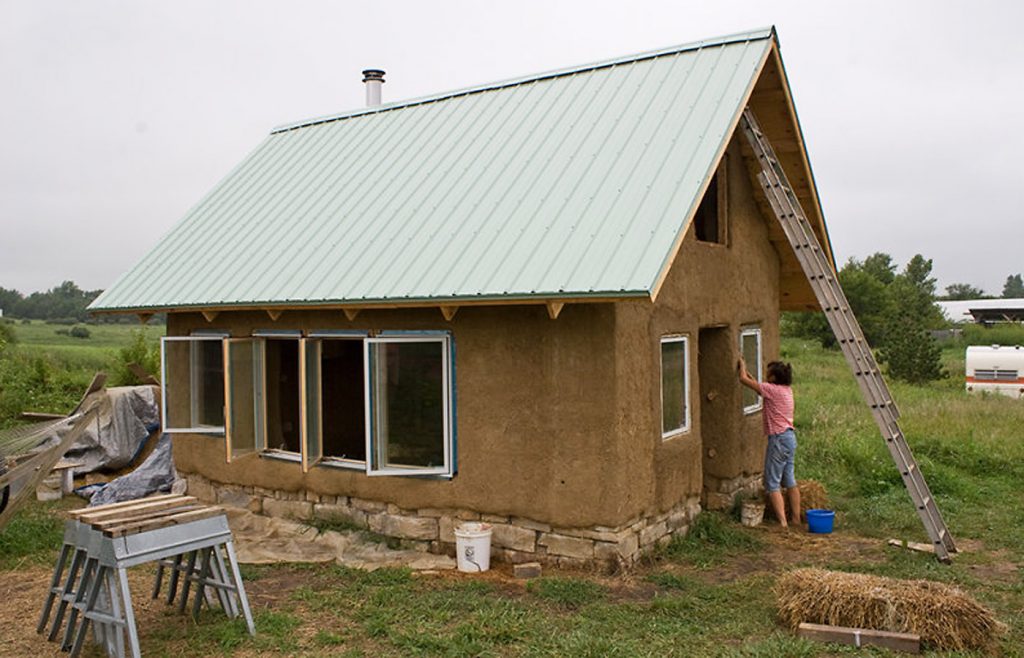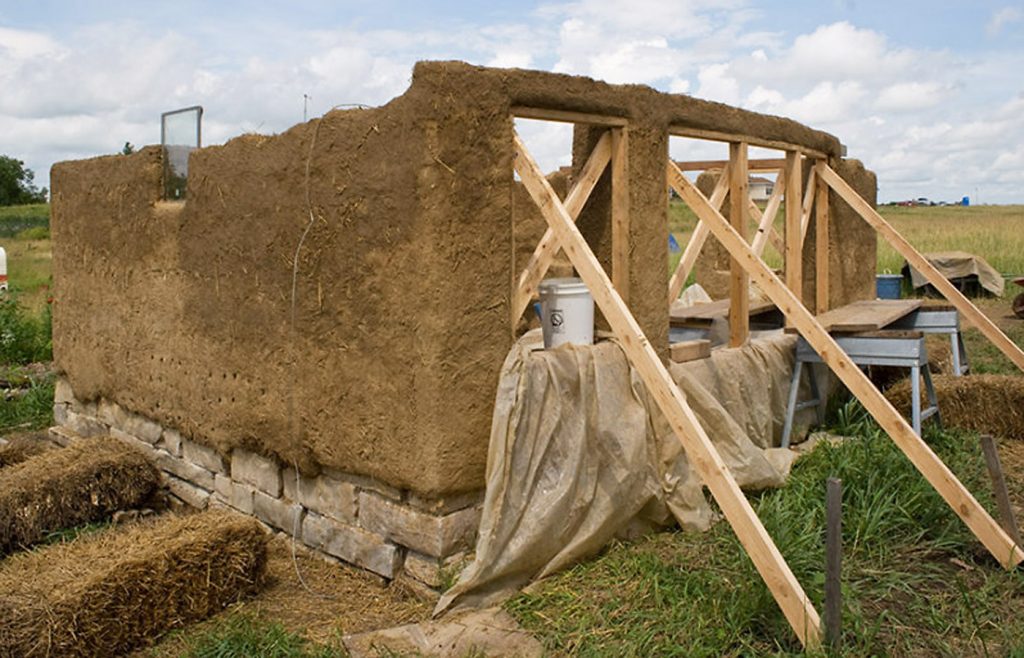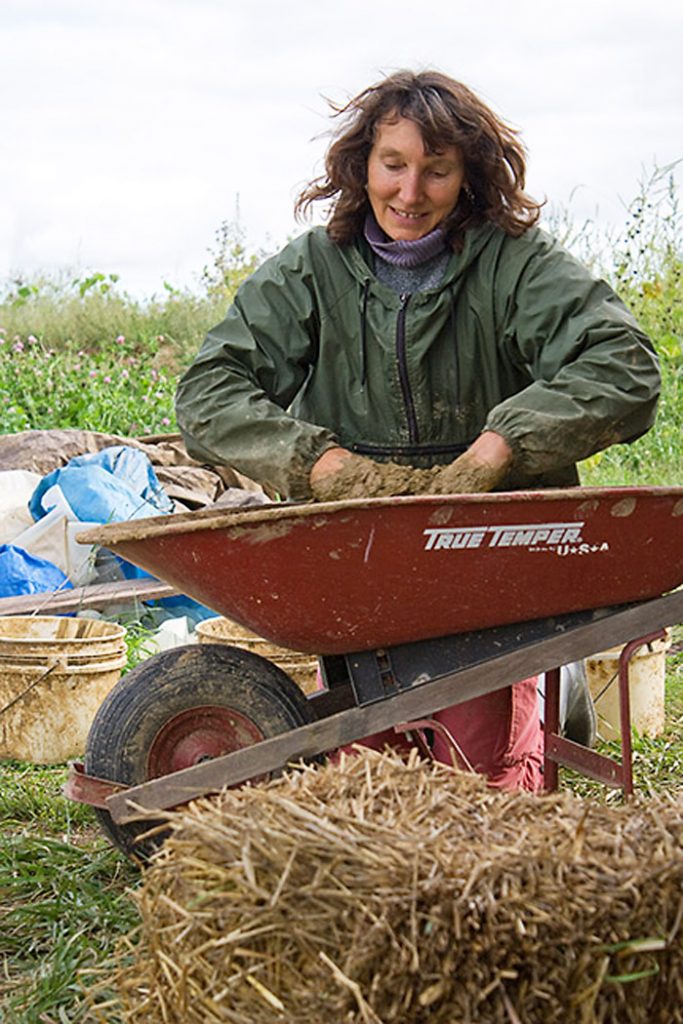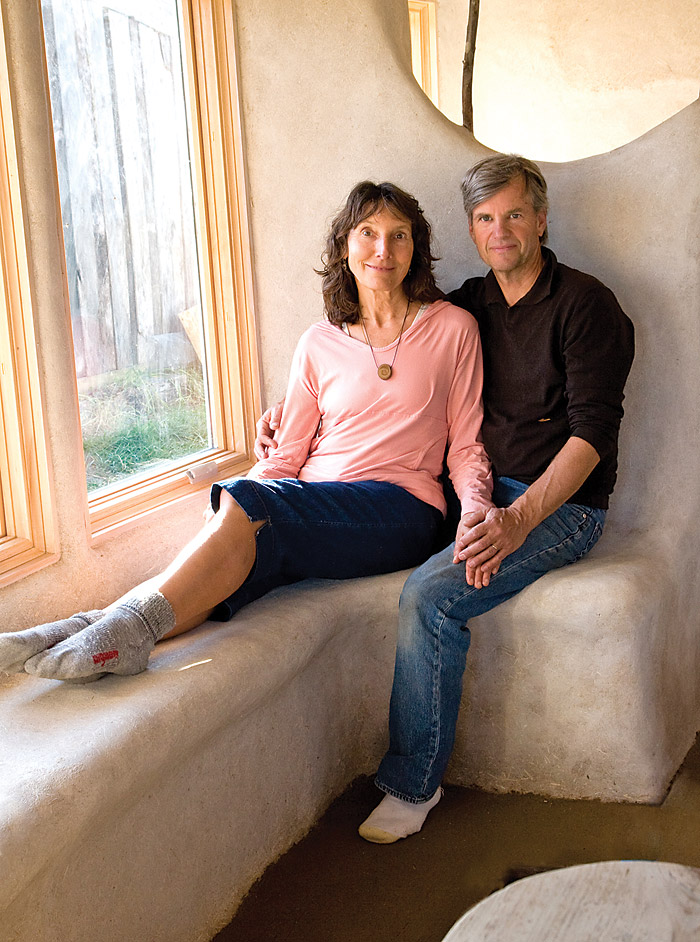
Lately, my friends Hap and Lin Mullenneaux have been building a cob (earthen) home with their hands—and their feet.
One June morning I rise early and make my way to their daily “cobbing” party, mixing earth from their own land to create massive 18-inch walls. Already the walls are a few feet high, sitting on a limestone foundation. The house will be small, with 400 square feet of livable space including a loft bedroom.
I’m the first one to arrive, so I get a little tour. Ten months earlier, Hap and Lin purchased a $700 camper on eBay, parked it on this acreage on the southern edge of Abundance Eco-Village in Fairfield, and moved in. They planted trees, built a hoop greenhouse that serves as an open-air garden in summer, and constructed a three-sided shed for their outdoor kitchen, shower, and workshop. For bathing, they catch rainwater from the shed’s roof in a 350-gallon plastic tank, then pump and heat it with a Coleman camper shower.
The place bursts with rustic charm. Nasturtiums, roses, and morning glories are blooming. The green prairie swells in gentle hills, and the air feels fresh, light.
Then we start mixing cob, as that’s what Hap and Lin do these days.

“It’s about two buckets of clay and two and a half buckets of sand,” Lin explains as she dumps first sand, then clay subsoil, and finally water on top of a tarp. We mash it with our feet. It’s smooth and cool and squishy. I follow her in a tight circle, slapping my feet in a happy, rhythmic dance.
After about a minute of foot mashing (Lucille Ball mashing grapes comes to mind), we grab the end of the tarp and roll half the clay on top of the other half, like a burrito, and start mashing again. Sometimes more water is added, and when the clay is ready, Lin sprinkles straw across the top and we mash that in too.
Other friends join us as the sun climbs higher, and now there are three tarps of clay burritos.

“Part of the appeal for this kind of building is that it involves community,” says Lin, “when your friends and family help build your home.” Hap and Lin have an abundant supply—they have raised five children in this town, and with their grandchildren and Hap’s mother, Dorothy Beal, their extended family spans four generations. Now in their 50s, Hap and Lin are the kind of people who live a simple, generous life and make friends wherever they go.
Soon we are grabbing the clay mixture with our hands and forming them into cobs. “Cob means ‘lump,’ ” says Lin in her quiet voice. With her strong hands (Lin works as a masseuse at the Raj Ayurveda Health Center), she teaches me how to pack the clay-straw mixture into dense balls the size of a small cantaloupe.
We have a big pile of cobs now, or at least Lin does—she’s managed to create three times what I have. The burrito has disappeared.
“Now comes my grandchildren’s favorite part,” says Lin. We form a human chain and toss the cobs from person to person in a rhythmical motion until the cob reaches Hap, who slaps it on the top of the wall.
Hap says the idea is to merge the cobs into a solid earthen mass. “Some people use a level, I do it mostly by eye,” he says.
He’s buried a sturdy pine sapling log called a deadman into the wall. “This is what we’ll hang the shelves on. Of course, we’ll probably wish we’d made a lot more, but as you can tell, we’re not so much the plan-ahead types. We let it unfold as it wants to.”
Hap smiles, his blue eyes bright under his sun hat, and you can tell he’s in his element, having the time of his life.
A Feel for Cobs
Cob building has been used for centuries in Europe but is relatively unknown in the U.S. In the summer of 2007, Hap and Lin journeyed to Oregon to learn cob building at the Cob Cottage Company, the home of Ianto Evans and Linda Smiley. They are the major force promoting cob building around the globe.
Besides their workshop in Oregon, Hap and Lin visited traditional cob cottages in England, where the technique has been used for centuries. There they met the renowned British cob builders Adam Weismann and Katy Bryce. Their book Using Natural Finishes provided valuable formulas for plastering and lime-washing the cottage.
In addition to their training and their books, Hap and Lin rely on intuition, trial-and error, and the feel of clay and sand and straw under their fingers and toes. “When you use living natural materials like this, they tell you what to do,” says Hap.
Now they hope to inspire and teach others to build their own homes with natural materials. Hap is the treasurer of the Sustainable Living Coalition, which is creating a campus adjacent to the Mullenneaux homestead. It will include a center for learning about sustainable living and courses such as Lonnie Gamble’s Big Green Summer program and, of course, natural building. Already, some of the volunteers on the Mullenneaux house are starting their own cob building projects in Fairfield.
An Affordable Dream Home
I stop by a few more times that summer, then suddenly it’s October and my husband and I bike to the Mullenneaux place. A lot has changed. The walls look fluffy as marshmallows. The cob has been covered with a render that includes fresh cow dung to provide a more water-resistant finish.

With a pristine-white lime-plaster finish, a steep green metal roof to catch rainwater, and a periwinkle blue door, it’s a fairytale cottage.
“Hap wanted the door to be the color of morning glories,” says Lin. The morning glories have climbed to the top of the arches over the garden and Hap’s mother Dorothy and her husband Bill Beal have planted a beautiful garden of their own, next to the camper where they have lived this summer. Dorothy shows us the roped-off square marking the home they plan to build next year.
But the cottage, the cottage. It’s a cozy, magical place, with a winding staircase to the wooden loft where the bed already rests, and two small baskets for socks and sleepwear are the only other furniture. Pine saplings, cut as dead wood by Hap from a nearby forest, form rustic beams downstairs. The partially plastered interior walls feel smooth and cool as stone. A wood stove sits in the northwest corner, cob benches create a window seat under the south windows.
The sunlight and crisp fall air flood through the doors and windows. I don’t have the feeling that I often have on such a perfect day, that I just have to get outside. It feels like I already am outside. Without the buzz of electricity (a single wire on the north wall, to be used for charging their computer, will eventually be powered by solar panels), I feel the kind of euphoria I often feel when visiting Amish families, who also live without electricity.
“The experience of building this house was completely different than the home we built ten years ago,” says Hap. “I don’t remember feeling so vibrant at the end of the process like I do now. These materials are alive.”
Hap shows us the tube that will bring cool air from the earth into a wooden cabinet under the dining table to refrigerate food. They will use lanterns and candles for light. For bathing they will heat rainwater caught from the roof on their stove, and are looking for a small sitting tub that requires very little water for a hot bath.
“This is an experiment,” says Hap. “To see what it takes to really live sustainably, to not be hooked up to electricity or city water. When a million gallons of rain water fall on each acre of land in Iowa, why do we need to be hooked up to a water supply?”
With only a week left before their projected move-in date on the full moon, Hap is finishing some carpentry work and Lin is smoothing plaster on the north interior wall. The plaster is made from kaolin clay, sifted sand, straw, wheat paste, and the magic ingredient—cattail fiber collected from a ditch earlier that day. One of Lin’s co-workers, John Pielemeier, drops by to help. He is one of over 50 people who have come to help and to learn over the course of the summer.
The cost of their dream house? They estimate $7,000. “And half of that was in the windows and roof,” adds Hap.
Early on, they made a decision not to go into debt for the house. The money saved on rent has covered the cost of building. In addition, friends have donated building materials, too many to list, and, best of all, free labor.
Lin’s eyes tear when she talks about the people who have given so generously of their time to help them realize their dream. “We’ve been humbled and awed by the degree of volunteer help we’ve received.”
She tells how last month they were about to sell their car to buy the wood stove. She was reluctant to do that; having taken so many family trips in the car, it was a part of the family. Then their friends offered their old woodstove.
“It’s been empowering,” says Lin, “to see how everything is taken care of. We are starting to feel like the lilies of the field.”
Hap says the house itself is a gift. “With materials coming out of the ground, with labor coming from so many wonderful friends and family, it’s a tremendous blessing that we’ve received. It feels like a miracle.
See more photos taken while building was in progress at Hap and Lin’s Cob House Journal.
Linda Egenes is a Fairfield-based freelance writer and author of Visits with the Amish: Impressions of the Plain Life, published by the University of Iowa Press.
